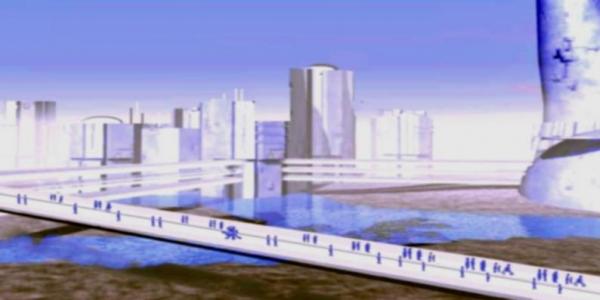BY LETTER
Slidewalks and RiverRoads
Technology > Technology Type or Material > Drytech/Hylotech
Technology > Application > Everydaytech
Technology > Technology Levels > High Tech / Hitech
Technology > Application > Infrastructure
Technology > Application > Transportation > Surface Transport
Technology > Application > Everydaytech
Technology > Technology Levels > High Tech / Hitech
Technology > Application > Infrastructure
Technology > Application > Transportation > Surface Transport
 Image from Steve Bowers and Juan Ochoa |
Slidewalks, or their larger cousins the RiverRoads, are a common mode of surface travel for short to medium distances in many parts of the Terragen milieu. They are often complementary with ordinary pedestrian travel or the use of self-powered ground vehicles. They are named as they are because they employ microscale or nanoscale mobile units to create a solid-seeming surface that flows in a constant direction at a pace that is acceptable to the average local passenger. The material known as Flo-stone is a popular choice for slow-moving slidewalks; faster versions tend to use specialised utility fog.
Narrow slidewalks have a single band moving at a single low speed. Broader courses have several progressively swifter bands, so that at the middle of a large riverroad it is possible to move along at tens or even hundreds of kilometres per hour. A typical riverroad or slidewalk can carry passengers or other objects massing up to three tonnes each under Terragen standard gravity, but industrial grade versions can move considerably more.
Sophisticated larger scale machinery beneath the layer of utility fog drives it forward in whatever direction and at whatever speed is required. It also supplies power to the u-fog and contains repair facilities for damaged u-fog units. In some cases this same machinery transports a counter-stream of the u-fog units from the strip's end back to its beginning, while in other cases the slidewalk or riverroad forms a circuit and the u-fog units return to their starting point aboveground. The u-fog surface is programmed for additional functions having to do with road-bed maintenance: the removal of debris, the shedding or absorption of precipitation, and temperature control. It also has numerous functions relating to the safety or comfort of passengers. Some slidewalks and riverroads carry seats or shelters for passengers who require them. Most often these are formed from the u-fog itself according to the kinds and numbers of passengers and their needs for privacy or shelter, but they may also be made of more standard construction materials. These shelters are especially common in the swifter middle courses of riverroads, since passengers would otherwise be buffeted by strong winds. They are also typical if they are located on the surface of a planet or large scale hab that has inclement weather.
Slidewalks and riverroads may be used even in cultures that otherwise make minimal use of u-fog technology. In some cities the entire transport system is based primarily on slidewalks and riverroads. These are usually in regions that see very heavy traffic, since for infrequent passengers it is much more energy efficient to power individual vehicles rather than move an entire road surface. Even with advanced technology an active slidewalk or riverroad produces heat which must be dispersed; this is an issue in some busy and crowded metropolitan areas.
Related Articles
- Flo-stone
- Groundborne Independent Quadrobile (GIQ)
- MultiModal Personal Rapid Transport
- Personal Transport Technology
- Triphibious - Text by M. Alan Kazlev
A vehicle that is able to travel on or under water, on land, and in the air. Triphibious vehicles are very popular on Pacifica. - Vac Trains
- Vehvecs
Appears in Topics
Development Notes
Text by Stephen Inniss
Initially published on 06 March 2007.
Initially published on 06 March 2007.






